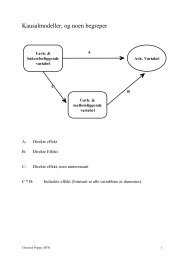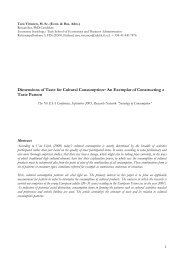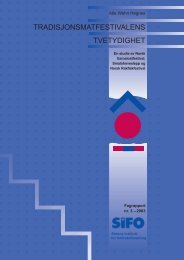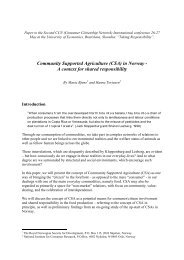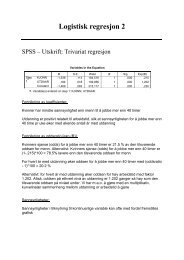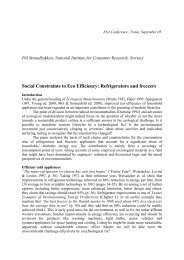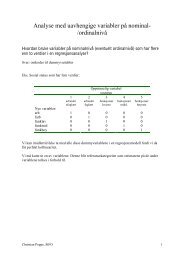Rapport nr - SIFO
Rapport nr - SIFO
Rapport nr - SIFO
- No tags were found...
Create successful ePaper yourself
Turn your PDF publications into a flip-book with our unique Google optimized e-Paper software.
6 Promotion6.1. AdvertisingThe means of promotion for each quality sign are principally leaflets and flyers directly in the salesplace, like a supermarket. However, PDO also uses more written media than the other signs of quality.For example, 2/3rds of managers used advertising for the promotion of PDO and labels. Furthermore,less than half of the persons in charge of a CCP used it. Advertising seems to be more and more important,shown in the rise of the number of quality signs. However, even if a PDO is well-known byconsumers, it still does not insure a total commercialisation of the products. Arguments employed byeach quality signs are different. For instance, appellations like PDO or PGI mainly use typicity andtraditional quality, as well as geographical origin and taste. The policy of labels is principally axed ongeographical origin, typicity and tradition, and then finally on taste. In the study of Agreste n°128,PDO use is based principally on tradition and typicity in their communication policy and labels thegeographical origin. On the other hand, managing the promotion of CCP is totally different becausethis label is principally to ensure sanitary quality; not only an insurance of safety quality of productionbut also of manufacturing. Furthermore, it refers to the geographical origin and as well as the traditionand typicity.Only Label Rouge uses arguments which seem different to its first prerogative. For instance, LabelRouge principally uses taste and not origin for communication purposes, while PDO uses more originthan tradition to be totally in coherence with the definition of these quality signs. However, for appellationslike “Champagne”, “Poulet de Bresse” or “Roquefort”, it seems to be logical to further promotetradition than origin, since origin is well-known to most people. For Label Rouge, it also appears normalto use origin for communication, since many of them are old regional labels, often created before1994. Except the organic AB Label, no label promotes the environment, which is often in the definitionand prerogatives of their label or appellation. 6The use of a logo for a quality sign concerns only 2/3rds of products and half of PDOs. Wine producersoften prefer the mention of an agricultural competitive examination medal rather than a PDO.6.2. The Terroir® imageMarketing strategies have tried to break down the Terroir® brand into different attributes in order tounderstand the main attributes which attract consumers. François d’Hauteville (2006) defines the conceptof Terroir® and typicity in its marketing. Terroir® seems have three parts. The first one is a tangiblereference to an agronomical-geographical area (climate, soil, etc), while the second part is intangibleand refers to know-how. The last part is an historical reference. These three characteristics definethe typical production places for Terroir®. In addition, Fort and Fort (2006) have also analysed the6 More information in Amilien, Ferras, Fort, 2006




